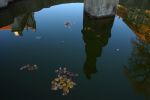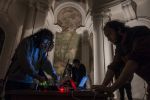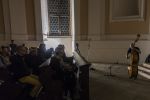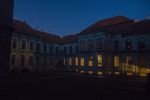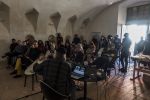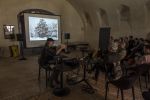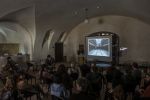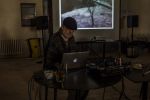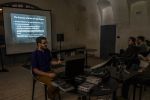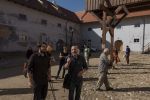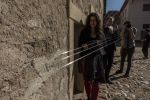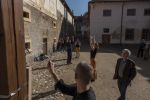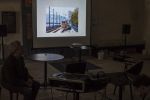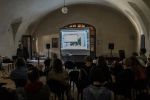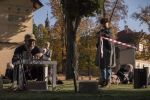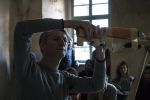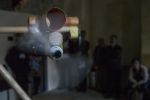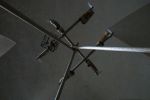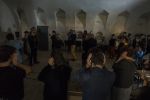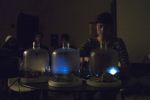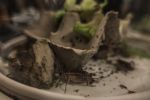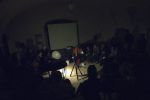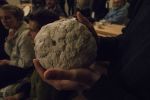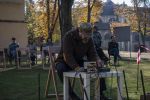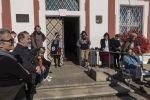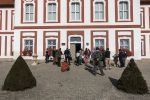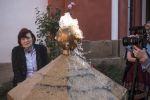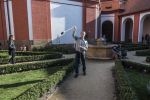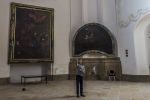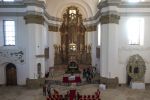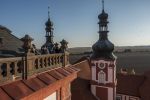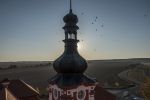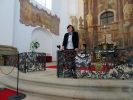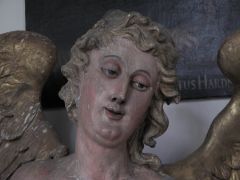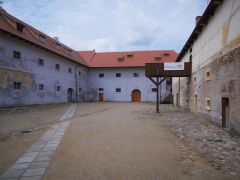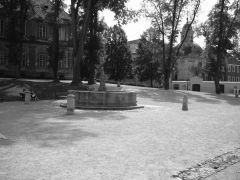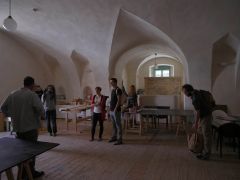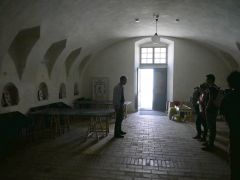What type of acoustic environment is beneficial or detrimental for people and other beings? Is there even such a thing as a natural, healthy acoustic environment which is fitting for humans, irrespective of other beings?
We assume that understanding the world through hearing – through listening – is as important for experiencing reality, orientation, sense of place and developing a positive relationship to the world and to other people, as is appearance (color scheme, tactile texture, variety), cleanliness, smell, or the composition of air, water or soil.
For generations, people have lived amid nature, that is in an environment which is very rich in sound. Landscape sounds have a broad spectrum of depth and dynamics, ranging from the silent to the loud, from the distant to the near. In the past few centuries, industrialization and, more recently, globalization have changed the world in many ways. The disappearance of many biological species has also impoverished the richness of the sound spectrum, and some of the processes of civilization which we have had to get used to are the standardization, flattening and increase in the volume of noise.
The interrelation of the “natural” and “artificial” noise environments is being studied by a relatively new, interdisciplinary field: acoustic ecology. Acoustic ecology studies the nature and effect of sound on the physical and psychological reactions of people who live in the given environment. A key concept is the so-called “soundscape,” which R. Murray Schafer understands as the relationship of the individual (or of a collective) to the outside acoustic environment. The soundscape includes aggregates of subjective perceptions, emotions which we (both consciously and unconsciously) experience, hear, register, measure or analyze. The soundscape is in a certain sense an objective part of a specific time and place, comprising a community’s shared aural heritage, co-creating its identity and the uniqueness of a place. It is a component in a wider psychological, social, and ecological context.
The shift in perspective is also very important for acoustic ecology: Are we able to understand how sound and noise influence other living beings? What is the character of certain soundscapes in interspecial and environmental contexts? Biophonics is a term used by acoustic ecologist Bernie Kraus, who is both artist and scientist, and who studies the transformations of soundscapes. Biophonics consist in the collective acoustic expression emitted by all organisms in a certain environment and a certain timeframe (including the vocal expressions of humans and other animals). Geophonics, on the other hand, collects the acoustics of, for example, meteorological and geological processes – volcano eruptions, the din of tornadoes and hurricanes, melting glaciers, falling stones, erosion of deserts and the crackle of electromagnetic waves. Stuart Gage’s term anthropophonics denotes those acoustic expressions which are related to humankind. Kraus notes that there exist effects of climate change which can not only be seen or smelt, but also heard.
Anthropophonics is undergoing a steady rise, and biophonics is changing at a global scale. The biotope of the forest, meadow, gardens, steppes, rivers, oceans, connected to the expression of birds and insects, amphibians and mammals is quickly disappearing from both our visual and aural horizons. Biophonics are becoming drowned out by the din of people, or rather by our ever louder machines and devices. Will we manage to adapt to such a fundamental change in our environment and, if yes, who will we then become?
Friday, 12 October 2018
11:00–12:00 Abbey stables: Registration
13:00 Mathey auditorium
Miloš Vojtěchovský / Vít Bohal: Welcome of guests, information about the program and introduction to the themes of the seminar
Pavel Kodera: Welcome of guests
13:30–15:30
THE SACRED AND THE PROFANE
13:30 Mathey auditorium
Irena Bukačová: About Light, Sound, Jan Blažej Santini-Aichel and Mauricius Vogt
In the sacred baroque space, communication and the accentuation of qualities of location is determined not merely by sound and acoustics, but also depends on the dialectics of light and darkness. In my talk, I will touch upon the important role of light in Baroque architecture and in architectural theory. Such Baroque musical theory was practised by the Abbot Mauritius Vogt in Plasy (Conclave magnae artis musicae). According to his theory, musical intervals correspond to the harmony of the Cosmos, which is imprinted via the concepts of Sacred Geometry and of the Kabbalah into sacred architecture.
PhDr. Irena Bukačová is a historian, journalist, translator, and the director of the Museum and Gallery of the Northern Pilsen Region in Mariánská Týnice. She studied philosophy, history, and art history at the Philosophical Faculty of Charles University in Prague, writing her doctoral thesis on the history of Italian philosophy. Her work focuses on historic preservation and the Northern Pilsen region.
Czech, 30 min
14:00 Mathey auditorium
Anna Kvíčalová: Church Acoustics in the History of Knowledge
Although Christian church building practices have produced some of the most acoustically impressive structures in Europe from the early Middle Ages to modernity, little is known about the acoustic models used in their construction. It is unclear to what extent the architects aimed for specific acoustic effects and what exactly they knew or assumed about acoustics. Architectural acoustics as an exact science capable of precisely calculating reverberation time emerged only after the physicist Wallace Clement Sabine determined the reverberation equation around 1900. However, the behaviour of sound – especially the sound of the human voice and musical instruments – in both enclosed and open-air spaces had been discussed within the context of rhetoric, music and the performing arts, religion, and architecture for many centuries. In my talk, I will argue that the history of church acoustics reveals the fluidity of boundaries between different regimes of knowledge. What we would today call an empirical and scientific understanding of acoustics was not necessarily in conflict with religious and cosmological views of sound and audition derived from ancient sources. The “hybrid” notions of sound and hearing generated in this context did not necessarily result in poor acoustic design due to a misunderstanding of the nature and propagation of sound. Rather, we can see them as reflecting a mix of practical acoustic, cosmological, and religious concerns, which met particular historical requirements and expectations.
Anna Kvíčalová PhD is a postdoctoral fellow at the Centre for Theoretical Study in Prague. She was trained as a scholar of religion at the University of Amsterdam (MA) and the Freie Universität in Berlin (PhD). From 2013-17 she worked as a research fellow at the Max Planck Institute for the History of Science in Berlin (research groups The Making of Acoustics in 16th to 19th Century Europe and Epistemes of Modern Acoustics); and until 2018 she was a member of the Berlin center on the history of epistemology and material culture (Knowledge in Motion). In her work, she deals with an interdisciplinary investigation of the history of the senses, media, science, and religion in early modern Europe. Her current project examines the construction of the categories of deafness and hardness of hearing, and changing definitions of “good” sound and hearing in 16th and 17th century Europe.
English, 30 min
14:30 Mathey auditorium
Pavel Kodera: Pots of Singing: Several Notes on the Resonant Vessels in Medieval Buildings
Shortly before the Christian era, Vitruvius wrote in one of the chapters dedicated to the education of the architect that “the builder must also have a say in music to understand sonic laws and mathematical theory of sound.” Further, he describes the correct placement of bronze vessels in the theater so that “the consonance of the actor’s voice was intensified and changed in such a way, to make it clearer and more pleasant to the ears of the audience.” In recent years, we can see considerable attention towards the phenomenon of resonant vessels especially in foreign literature. About ten individual articles have already been published in the Czech context. The talk will focus on this issue located at the edge of architecture and acoustics.
Mgr. Pavel Kodera Ph.D. is a director of the Centre for Building Heritage in Plasy. He studied Cultural History at the Pedagogical Faculty of the University of South Bohemia in České Budějovice from 1992-97, and in 2008 he graduated in History of Architecture and Reconstruction of Monuments from the Faculty of Architecture of the Czech Technical University in Prague (Ph.D.). He worked as a specialist at the Archives of the Academy of Sciences of the Czech Republic (1997-2005), at the Research Center for the History of Science (Academy of Science and Charles University) and at the Faculty of Philosophy of the University of West Bohemia in Plzeň (2005-10). In the period 2004-11 he worked as an archivist of the Archives of Architecture and Civil Engineering.
Czech, 30 min
15:00 Mathey auditorium
Yiorgis Sakellariou: Between The Physical And Supernatural: Sacred Soundscapes and Electroacoustic Music
A church, like any temple, can be regarded as a sacred space. Is there an essence of spirituality embedded in its aural atmosphere or is this something imagined by the visitor? Can the soundscape of a church transmit an exclusively religious message or perhaps it can have a purely sonic and musical context? This lecture will address these questions by describing the methods of composing and performing Silentium, an electroacoustic piece based on sounds of churches, bells, and organs. Exploring the sacred soundscape of a church initiates an aesthetic inquiry into sounds of religious origin with the aim of opening up a discourse about sacred and secular spaces in relation to acousmatic music performance and listening. Moreover, Silentium examines the contrast between the mundane and chaotic urban noises and the attentive worshipful silence of a concert. The act of listening to Silentium is an immersion into what historian of religion Diarmaid MacCulloch has described as a border zone between the physical and supernatural.
Yiorgis Sakellariou is a composer of experimental and electroacoustic music. Since 2003, he has been active internationally, being responsible for solo and collaboration albums, having composed music for short films and theatrical performances, leading workshops and ceaselessly performing his music around the globe. His practice focuses on the communal experience of listening and the communication between composer, audiences, performance spaces and the rest of the physical and supernatural world. He only performs in absolute darkness, fostering an all-inclusive and profoundly submersive sonic experience. Sakellariou was awarded a PhD from Coventry University in April 2018. His research drew inspiration from ethnomusicological and anthropological contexts and explored the sonic symbolism and socio-aesthetic settings in ecstatic religious rituals in relation to field recording, electroacoustic composition and acousmatic performance.
English, 30 min
15:30–16:00 Break
16:00–18:00
LANDSCAPES, ECOLOGIES, SOUNDSCAPES
16:00 Mathey auditorium
John Grzinich: Totems of Linearity
Much of the landscape is strewn with artefacts of linearity. Inscriptions of human transmission coded and uncoded demarcate borders, electro-materialist dependency and radio-teleological communication systems. Points may be connected via visible lines of wires or arrays of invisible signals transmitted via techno-telepathic networks. Physical in every aspect, these artefacts expose the parallel worlds of modernity yet remain isolated from their surroundings, standing out as sculptural figures traversing the open land. As structures unto themselves, they can be intrusive and out of place. Should obsolescence of their intended purpose set in by circumstances entirely unrelated to their location, they will either be left to weather, occupied by vegetation or recycled for their material value.
John Grzinich (b. 1970 New York) lives and works in Estonia and has worked since the early 1990s as a freelance mixed-media artist and cultural coordinator with various practices combining sound, image, sites, and collaborative social structures. His primary interest is working with sound, combining such divergent methods as field recording, filmmaking, electro-acoustic composition, performance, acoustic perception and listening awareness. He has performed internationally and regularly conducts workshops using sound as a collaborative medium. Additionally, Grzinich has created experimental video works since 2000, often in combination with his audio work. In 2010 he completed his first two film works, minema, and a treatise on sound and site-specific activity Sound Aspects of Material Elements, both of which were screened internationally and then published on DVD by the US label and/OAR (2012). He is continually attempting to rethink the cinematic form with an emphasis on the sonic experience, leading to a more living, animistic view of landscapes, objects, the built environment and those who interact with them. Since 2003, Grzinich as served as an event and project coordinator at MoKS, an artist-run international residency center and project space in southeast Estonia.
English, 30 min
16:30 Mathey auditorium
Taufan ter Weel & Sara Pinheiro: Sense of Space-time
DISCUSSION
Our sense of space-time is historically and geographically divided. In other words, the ways in which we experience, conceptualise and organise (or relate to) space and time are intertwined with social, cultural, technological, political and economic developments — both local and global. The lecture focuses on the tension between abstractions of space/time and site-specificity — between dominant models or representations of space and/or time (Cartesian, Euclidean and non-Euclidean geometry, Newtonian logic, but also scientific management, Fordism, algorithmic programming, smart control) and what is called sense of place or situated knowledges and rhythms — which seems apparent in the global history of colonial and industrial capitalism.
Taufan ter Weel is an architect, artist and researcher who takes an interdisciplinary approach at the intersection of sound art, architecture and socio-spatial research. Besides carrying out collaborative and independent projects, he works as a guest teacher at TU Delft’s Faculty of Architecture (Theory Chair), where he also received his master’s degree in architecture with honourable mention in 2009. He has worked as part-time instructor (2009–2012) and guest teacher (2013–2014) at The Hague University of Applied Sciences (Built Environment department), where he received his bachelor’s degree in 2006. In addition, he was a research member of Cohabitation Strategies in Rotterdam (2009–2010) as well as the artistic leader (2010–2012) and co-leader (2013–2014) of Blikopener Festival & Productions in Delft. He has performed live electronic music since 2001 and followed the Institute of Sonology’s one-year course program (2011–2012) at the Royal Conservatoire The Hague. – link
Sara Pinheiro (b. 1985) is a sound-maker. In her art practice, she makes acousmatic pieces, usually for multichannel performances, radio broadcasts, or installations. She is a member of the live-coding group K-o-l-e-k-t-i-v and collaborates with the Barrandov CinePost Studios, now PFX, and Bystrouška Sound Studios in Prague. She graduated in Cinema (Lisbon, 2008) and holds a Master of Music in Sonology (The Hague, 2012), where she is a guest lecturer. She has been part of the teaching committee at CAS – FAMU since 2013. Her academic work is practice-based research which she calls “Acousmatic Foley”. – link
English, 30 min
17:00 Abbey stables
Petra Kapš alias OR poiesis: Doors to Paradise
Doors to Paradise addresses the edge of the imaginary and confronts the barrier of the (not)allowed. Liquid phantasy of micro locality. The work falls within the scope of the author’s devotion to the phenomena of the wall, paradise, body, voice, rivers. The flowing fleetingness of the captured voices in the language of the water continues its cosmic eavesdropping. In the intimacy of the interior regions, the fountain recalls the uncertainty, the hearing awakens.
Talk about the performative piece Doors to Paradise and presentation of the artist book The Golden Walls, a short version of the sound performance PARADISCO.
Petra Kapš alias OR poesis (b. 1975, Slovenia) weaves her work among the arts of sound, radio, chrono-spatial poetry, poetic performance, books and reflection. Aside from the ethereal features of sound, she focuses on the physical presence of the body. She extends the word, her core medium, with sonic spheres of sonorous poetry. Kapš is interested in aural memory and the deep time of the body. Incorporating an (a)syntemporal presence through the digital sphere, she researches the possibilities of intimate radio and is concerned with the void ear of the internet listener. Her sound/radio/book works are located solitudes.
English, 30 min
17:30 Abbey stables
Jez riley French: The Choreography of Perception
The works of Jez riley French include pieces capturing the sound of the dolomites dissolving, ants consuming fallen fruit, the Tate Modern building vibrating, the infrasound of domestic spaces around the world, glaciers melting in Iceland, and the tonal resonances of natural and human objects in the landscape. Recent projects and research include “design and detail of the spaces between buildings” in Japan and “salts”. French makes use of intuitive composition, field recording, improvisation, and photography, and has been exploring his enjoyment of and interest in detail and simplicity and his emotional response to places and situations for over 3 decades. Alongside performances, exhibitions and installations, French lectures and runs workshops around the world. His range of specialist microphones is widely used by recordists, sound artists, musicians, sound designers, and cultural organisations. He also works as a curator of live events, a record label, sound installations and an art zine Verdure engraved. In recent years French has been working extensively on long-form recordings of surfaces, spaces, and situations and developing the concept of photographic scores and “scores for listening,” which have featured widely in publications and exhibitions.
English, 30 min
18:00–18:30 Break
18:30 -19:00 Hodiny, st, Bernard chapel - sound performance Martin Marek, Jan Kromholz, Iva Polanecká, Polina Khatsenka (UJEP)
19:00 - 19:30 Convent st. Benedict chapel
George Cremaschi: Improvisations for contrabass and hyper-resonant space Cremaschi was born in New York, where he studied music and composition. He later lived for many years in California and currently lives in Prague, where he teaches film sound at FAMU. Cremaschi makes use of a variety of approaches in the overlapping areas of music, sound art and noise. In thirty years as a composer and performer, he has a long and diverse history of working with musicians, filmmakers, dancers and choreographers, visual artists, and writers. Some of his current projects include the groups KRK (with Matthew Ostrowski), Rohr Rohr (with dieb13 and Gino Robair) and Lambs Gamble (with Fritz Welch and Eric Boros). Cremaschi is also a co-founder (with Petr Vrba) and director of Prague Improvisation Orchestra (PIO), a 15-member group that performs conducted free improvised, and graphic scores. As an improviser he has worked with many people including Liz Allbee, Marshall Allen, Han Bennink, Greg Goodman, Mats Gustafsson, Joelle Leandre, Thomas Lehn, Paul Lovens, Louis Moholo, Butch Morris, Evan Parker, Rova Quartet, and Cecil Taylor. As an interpreter, he has performed works by many composers including Adamčiak, Andriessen, Braxton, Cage, Cardew, Nicolas Collins, Feldman, Mingus, Oliveros, Penderecki, Tenney, Xenakis, among others, and has appeared on over 40 recordings on Apestaartje, Beak Doctor, Black Saint, Emanem, Evander, Evolving Ear, Leo, Music & Arts, Nine Winds, Rastascan and other labels.
20:00 Ian Mikyska: Plasy Silence (a workshop) A participative performance exploring the acoustic properties of the Plasy Monastery and its two chapels. The audience members – who are also the performers – receive a small folded booklet with instructions which they gradually leaf through as the piece progresses. A repeated return to silence and the various manners in which a group can approach and achieve quietude and stillness are at the heart of the piece.
Saturday, 13 October
10:00–12:00
RESONANCE AND LISTENING
10:00 Mathey auditorium
Miloš Vojtěchovský/Radoslava Schmelzová: Images from Plasy/À la Recherche du Temps Perdu
Video Projection
The cultural layers of the former Cistercian monastery of Plasy have an almost millenium-long history, but the media archive concentrates mainly on the events initiated by the Hermit Foundation and later the Center of Metamedia Plasy. This series of activities began in the winter of 1991 and lasted until the winter of 1999. In spite of their relative longevity, there is rather little reference material about these events circulating in the public sphere.
Radoslava Schmelzová Mgr. studied art history and cultural heritage management at the University of Ostrava, and the theory and history of design and new media at the Academy of Arts, Architecture and Design in Prague with theses about the project Hermit Foundation..She has worked as an assistant curator at the National Gallery in Prague, the National Heritage Institute, and at the Atelier Contemporary Art Journal. She is currently teaching theory of art for the DAMU program Theatre in alternative space. She is interested in the relationships between contemporary art, the landscape and cultural heritage.
Miloš Vojtěchovský (b. 1955, Prague) is a curator, art historian, and audiovisual artist. In 1991 he initiated The Hermit Foundation/The Center for Metamedia.Since 1997, he has lectured on media, contemporary art, and media theory and history at the Faculty of Fine Arts at the Technical University Brno. Since 2004, he lectures on media art history and theory at the Center for Audiovisual Studies at Film and Television Faculty at the Academy of Performing Arts in Prague. – link
10:30 Mathey auditorium
Rajesh Mehta: Sounding Buildings – Unfolding Frames cancelled
George Cremaschi: Music, Acoustics, Architecture
Improvised talk about the working strategies of musician in resonant spaces .
English, 30 min
11:15–11:30 Break
11:30 Mathey auditorium
Ian Mikyska: Sensory Strolls – Contemplation, Reading and Solitude in the Economy of Attention
If we are living in an “economy of attention,” how we direct our attention through reading, looking, listening and being is crucial in constructing our relationship to the environment and being in time. I will discuss my own work in relation to approaches (through text and listening) to ideas of the everyday, waste, impermanence of experience in self, with the goal of articulating a concept of personal contemplative politics, with connection to current trends in philosophical thought, including new and speculative materialisms, as well as ideas on time from Bergson and Deleuze. I will mostly focus on a series of “sensory strolls,” book-guided installations made in Prague (Convent of St. Agnes – National Gallery) and Pardubice (Automatic Mills) in 2017. The visitors receive a small booklet, which provides both maps and instructions for navigating a particular path through the space, as well as “scores”: instructions for performative events. These events, however, are generally not outwardly performative, and rather involve “performing” with one’s senses: seeing or hearing or touching in a particular way, with a particular focus. Each of these walks was tailored to a radically different space: The memory of these spaces was crucial in both walks, as well as the theme of solitude in concentration. While in Pardubice, topics of technology, utility, uselessness and our sensory apprehension of these elements were dominant; in the Convent – a much more public space – solitude and contemplation were more present. In both cases, finding new ways to engage our environments in a contemplative manner, thus reclaiming (public) space, is a central concern.
Ian Mikyska is a Czechoslovak composer who generally works on the edges of sound: he makes installations, walks, videos, texts, as well as sound in collaboration with other artists. He works in theatre, film, dance and radio. In 2016, he published his first book, Partitury pro čtenáře (Scores for Readers). In 2017, he prepared two “sensory strolls”: installations with guidebooks focusing on sensory perception. He co-founded the multimedia improvisation ensemble Stratocluster, who have recently published their newest CD Éternagy.
English, 30 min
12:15–13:30 Break
13:30 Abbey stables
Csaba Hajnóczy: What Are the Thoughts Behind CESSE? (Central European Society for Soundscape Ecology)
The first conference of the Central European Society for Soundscape Ecology, which will take place at the end of November in Budapest, will be dedicated to the establishment of a new organization for convening and coordinating energies towards the improvement and saving of our region’s soundscapes. Keywords include contemporary art, science, and technology, focusing on liveability and sustainability. The original idea was to connect motivated people, coming from various backgrounds, in the Visegrad countries. Soon the circle expanded to other countries as well.
Csaba Hajnóczy (b. 1957) is a musician, composer and musicologist living and working in Budapest. He teaches at Moholy-Nagy University of Art and Design, Budapest. His recent interest is field-recording based composition and the use of spatial sound systems. Individual projects and events include: Tuned to Magurski Park – electroacoustic concert in Krempna, (Poland, 2016); Mediawave Festival: 2002, 2005; Trafó Budapest: 2005; A38: 2003, 2008; Millenáris: 2007; Marosvásárhely/Tirgu Mures (RO) 2008; etc. He is the main organizer of the CESSE conference on acoustic ecology scheduled for the end of November.
English, 30 min
14:00 Abbey stables
Miloš Šejn: A Nightingale with a Flat Flight, Path in Translation
I record a moment of the nightingale’s living space. I have entered his house, his home. Reflections of vegetation, overhanging willows, and viburnums on the surface of the water say something of our, yes, perhaps our dialogue. I don’t know what the avian beings truly see and feel, but I am enraptured by the visual impression of this moment. When I wake up early in the morning, I lie on my bed and the branches from the garden stretch in from the window, clouds, the first rays of sun, and birdsong, it’s a perfect situation. Half asleep, loved ones and acquaintances approach, my consciousness is just as much between corporeality as between a dream and the consciousness of the house. I don’t know how the singing birds perceive this moment, and I know even less how long it has been since people have tried to capture this musical stream of speech in their own language – probably since time immemorial. Various languages and dialects hear something different each time. What follows are examples of translations of nightingales from the history of ornithology. And do we hear today at least some of a fragment of the nightingale’s building of a house?
Miloš Šejn (b. 1947) is a visual artist and performer who addresses issues of visual and sonic perception. He organizes workshops, such as Bohemiae Rosa. Since the early 1960s, he has been journeying and photographing, drawing, collecting and describing his observations of nature. He currently focuses on the immediate creative possibilities of addressing the relationship of humanized landscapes and intact nature. Consciously, the artist has woven his work between expressive language and text, visual tracks, body movement, voice and expansion into space. One of his recent large realisations is The Mountain of Dreams, made in cooperation with the project Sluňákov House of Nature in Litovelské Pomoraví. Miloš Šejn participated in the very first Hermit symposium in Plasy in 1992. In 1994, he also attended Hermit III: Průsvitný posel (Transparent Messenger), and the same year participated in the international meeting Fungus: Inquiry of Place (1145–1995). In 1997, together with Dutch dancer Frank van de Ven, he organised the international interdisciplinary workshop for visual artists and dancers Bohemiæ Rosa in Plasy – link
Czech, 30 min
14:30–15:30 Break
15:30 Mathey auditorium
Vít Zavadil/Stanislav Abrahám: Acoustic pollution in current and former military areas
The problem of acoustic pollution makes it difficult to record bird and frog votes. In this sense, the best pictures were taken in functional military slopes, where about two times a year there were several military exercises, then there was peace and acoustic background was almost zero. After 1989 there were some military training facilities 1) abolished, right in the 1990s: Dobrá Voda - now part of Šumava NP, Mladá (Milovice), Ralsko, in the last years Brdy-Jince (today Protected Landscape Area Brdy) 2) others were diminished and with the relaxation of the social conditions there is also less access to the access (Hradiště-Doupov, Boletice, Libavá).The first case led to the colonization of the development activities of these areas, in the second case, tourists, cyclists, bikers, riders on quadricycles, and so on. In both cases, there has been a disturbance in peace, so taking pictures is difficult here. In the past, heavy military technology has created a convenient biotope for species that have almost disappeared from the intensely agricultural and forest-based landscapes during the past century. In the context of a change in military strategy and technology, these territories lose importance to the extent that nature conservation somewhere creates similar management for nature in cooperation with lovers of historical military weapons and technology. This happens only in places and the former beautiful and rare fauna inhabited areas often lose importance.The soundtrack is a collage of several recordings (mixed by A. Stanko): slamming the garage door for tanks in the deserted military space of Ralsko, rain, penetrating into the abandoned semi-destroyed oyster plains on Kraslicko district (chorus singing in the background) and choir singing kvíčaly at the former military shooting range Vrchbělá.
Vít Zavadil (b. 1953) is an ornithologist, batrachologist, herpetologist, music critic, poet and ecologist. He studied medicine in Pilsen, but he is engaged in zoology and recording voices of birds and amphibians. He worked as a zoologist at AOPK CR, now he is employed in the same position at ENKI Třeboň, o.p.s. He is the author or co-author of a number of professional studies and books mainly in the field of batrachology and herpetology and has also published two books of fiction under the pseudonym.
Stanislav Abrahám: Drone
This installation reflects on three aspects of the sonic medium. Temporality or duration, typical for so-called drone music. Duration expresses the character of time, not “running” or “passing” by, but existing instead as constant presence.Resonance as an elementary means of amplification. Resonance is more than listening. It is tuning in to a common vibration. This way, vibrations are amplified. The principle of resonance is encompassed in the oldest musical experiences of humanity, in the form of throat singing on the Tuvan steppe or the musical bow of the Amazon rainforest. In the installation, this principle is represented on two levels. The first are small resonance tubes, placed above the propellers of the fans. The second level consists of the resonance of the resultant harmony in the acoustics of the chapel. The non-musical sound object as instrument contains a layer of higher resonant frequencies that interfere with one another. Then we can hear music created from sound in which we would not search for music.
Stanislav Abrahám is an audiovisual performer and sound artist. As a sound designer, he works in collaborative projects in the field of theater and dance production, as an independent artist he has realized installations in galleries, radio-art composition for Czech Radio or conceptual work with sound in public space. Ephemerality of audio media then replaces personal involvement or humor in performance or work with objects and concepts in the installation. His main interests include telecommunications, recording media and the phenomenon of “disembodied voice”. Professionally devotes to studio production work, field recording and postproduction of audiovisual works.– link
Czech, 30 minutes
16:30 Mathey auditorium
Judit Emese Konopás: Engaging in the Present and Letting Things Flow
The project I will present was created during my stay in the Czech countryside, where I was focusing on nature, as well as urban life and the impact this has on nature. The forest enfolds people in intimacy. It still has the energy to let us be present with it. The piece shows how nature and the disturbance of it creates a pair influencing one another in various layers and textures. If the urban environment changes, nature will soon follow, with changes in both the flora and the behaviour of animals. Their changing attitude and voice and the effect this has on urban living influence each other back and forth. Listening to and looking at these effects, we can arrive at a feeling of interrelation. We are all dependent on one another irrespectively of the direction of our attraction towards each other.
Judit Konopás is an architect, sound researcher, artist, and organizer involved in various sound-based activities. Her music was presented and screened at IZA Movie on the 14th Verzio International Human Rights Documentary Film Festival in Művész Cinema. She made her debut in Brusells performing her piece INTER/ACT/SON at La Semaine du Son festival. She also leads workshops and lectures at different universities and artistic venues. Recently Konopás has been experimenting in the field of sound and space involving various techniques using her own voice and body in order to better understand how sound can travel in space within undefined time.– link
English, 30 min
17:00 Convent entrance
Davide Tidoni: Listening/Intervention Workshop (introduction)
This workshop resembles an extended performance where participants become actively involved in the creation/experience of the proposed activities. Far from being confined to the sonic domain, the workshop introduces concepts and principles that can easily be appropriated and applied to other research fields. In this respect, it functions as a stimulus for interdisciplinary practice and as a context for experimentation.
Davide Tidoni is an artist and researcher working in sound and listening in a variety of formats that include live performances, site-specific interventions and listening workshops. The workshop involves the presentation, direct experience, and discussion of a series of listening pieces selected from his recent production. The workshop is open to anyone concerned with the possibility of interaction between sound, space and listening. Through a series of pieces and exercises that stage specific acoustic phenomena, the workshop encourages the active role of the listener and his/her own potentials to perceive and engage with sound. The main aim of the workshop is to offer a wide range of listening experiences in order to lead participants to recognize sound as a concrete presence that puts the listener in relation with space and other people’s bodies. – link
Participants: minimum 3, maximum 15.
Duration: 3 hours
The workshop will take place in English on Sunday from 9 to 12.
To sign up, send an email to sound@agosto-foundation.org.
17:30-19:00 Break
19:00 Abbey stables
Martin Zet: Transmutation
Sound event – gypsum, 10 minutes
dust from stone through heat
stone from dust through water
atoms molecules bonds
change warms
the shallowness of squelching
will ring out
will sound out
Martin Zet (b. 1959) is a visual and performance artist. He lives in Libušín near Kladno. In his work, Zet enlists the aid of replicas of specific visible features to reference their meaning. He makes use of the possibilities of the mutual interchange between the nearby and faraway, the known and unknown, the spoken and unspoken, and the concrete and abstract. – link
19:15 Mathey
Jakub Wagner and Martin Klusák: Krastí
We will present an ongoing set of four short experimental film poems focusing on the relationships between internal and external landscapes; the margins of plains, forests, the city, myth, and imagination. Each film is the result of a creative collaboration. The filmmakers are: the documentary filmmaker Květa Přibylová, the composers Martin Klusák and Jan Rybář, and the musician and filmmaker Marek Matvija. The authors explore the boundaries of the visual and sonic, accenting – rather than narrating – the rhythm and movement. Krasti is a crossmedia work to be presented as a series of short films and as a video projection accompanied by live music, produced by GPO Platform (Jakub Wagner, Martin Kohout) and Music in Context (Jan Rybář). The project is currently in the shooting and post-production stages.
Martin Klusák (b. 1987) is a Czech composer and audiovisual artist. He studied both classical composition and music for film (Film and Television Faculty of the Academy of Performing Arts in Prague). In 2010 he started studying at HAMU under the tutorship of Ivana Loudová. Despite the fact that his early works are inspired by the visual element and their form resembles free fantasies, his current work stands on rigorous musical and mathematical concepts, and is close to minimalistic and polyrhythmic thinking. Among his most significant competition successes are the 2011 award for the best Czech electroacoustic piece in the competition Musica Nova (Engineer Charon) and, in 2012, the main prize in the international competition of the Prague Philharmonic Choir. – link
Jakub Wagner is a screenwriter, director and producer. In 2002 he graduated at the FAMU, where he continued his studies at the department of the documentary, where he graduated with the film Family Affairs. He is the author of documentaries Profile - Jan Kaplický (2004), Váňa (2012), and producer of the documentary film The Epopee Complex (2018).
20:00 Abbey stables
Saša Spačal: Sound Performance
Saša Spačal (b. 1978) is a post-media artist, living and working in Ljubljana, Slovenia. Her work is at the intersection of living systems research, contemporary and sound art, focusing primarily on the posthuman period, when human beings exist and act as one of many elements in the ecosystem and not as sovereigns. She has exhibited and performed at venues and festivals such as Ars Electronica Festival, Prix Cube Exhibition, Transmediale Festival, Onassis Cultural Center Athens, Eyebeam, Cynetart Festival, National Art Museum of China, Museum of Contemporary Art Metelkova – MSUM+, Kapelica Gallery, Pixelache festival, Device_art, Art Laboratory Berlin, Kiblix Festival, Gallery of Contemporary Art Celje, Museum of Contemporary Art Vojvodina, and the Lisboa Soa festival. For her work, she was awarded Prix Ars Electronica Honorary Mention 2015 and nominated for Prix Cube 2016. She is currently participating in the Agosto Foundation artist residency program in Prague. – link
Sunday 14 October
09:00 – 12:00 The Convent and environs
Davide Tidoni: Listening/Intervention Workshop
10:00 – 12:00 Abbey stables
Open forum for contributions and discussion
Exteriors/Interiors
John Grzinich: Resonant Geometry is a performative exploration in redefining geometric space through the phenomenon of resonant feedback. The framework of the project is based on a tempered or adjustable system intended for real-time performance using tensioned lengths of instrument wires that act as both real and metaphorical lines that define space. The dimensions of this space will be measured by the sonic responsiveness of the signals in the system. In this way, not only does the installation itself function as an instrument but becomes an extension of the space itself. The wires resonate when induced with direct signals to generate electronic tones resulting from the physical movement of the wires. What we hear, in a sense, is an auditory translation of a spatial dimension. Such an experiment is based on speculative reasoning, to “measure” the degree to which a space has an inherent “tuning” based on its geometric proportions. The point to point 2-dimensional lengths of wires can be extended, woven and crisscrossed in a 3-dimensional space adding complex layers of tonality, dissonance and harmonics to the auditory translation process.
Sound installations and interventions by students from AMU in Prague and Faculty of Art and Design UJEP in Ústí nad Labem: Tomáš Roček, Martin Marek, Adam Hejduk, Zuzana Šklíbová, Jan Kromholz, Iva Polanecká, Polina Khatsenka, Matěj Šenkyřík.
12:00 Lunch break
13:08 Bus trip to Mariánská Týnice. An introduction to the space of the monastery by Irena Bukačová and Hana Blochová.
Returning around 6 PM.
The Monastery Church of the Annunciation of the Virgin Mary in Marianská Týnice and its central dome will be sounded by a capella voice, string instruments, bells and the music of the spheres.
“Musical harmony used to be related not only to the – to Musica Universalis, Music of the Spheres – but also to the Microcosmos – to the ‘composition of the human soul.’ String instruments, such as ancient harps or lyres, were tuned according to the ‘tones of the planets,’ and in the ancient times each tone was dedicated to a certain muse. Also, the Gregorian chant created a sequence of overtones, consisting of parallel ‘angelic choruses.’ Sacral architecture, erected according to the theory of ‘sacred geometry,’ developed huge resonant boxes, which were supposed to harmonize the Universe, the Earth and the human mind. Sonic geometry of sacred chants in sacral Baroque architecture often created sonic streams, 'alchemically' transformed into light streams.”
Hana Sar Blochová
RNDr. et Mgr. Hana Blochová graduated with a degree from the history of visual arts at the Faculty of Humanities and the Faculty of Science of the Charles University in Prague, but also studied the technology of art restoration at the Institute of Fine Arts in Prague and art criticism at the Faculty of Arts of the Masaryk University in Brno. She is the author of several books devoted to the field of art, history and philosophy, focusing mainly on philosophy, music, architecture and the fine art of antiquity and the Middle Ages. Since 2017, she has been the director of the "Kvadrivium" - Karlštejn School of Liberal Arts. She studied singing, piano and organ, flute and harp. She plays replicas of Medieval and Renaissance musical instruments: organ portatives, harps, psalteries and flutes. She performs solo, with the Kvinterna ensemble and other groups who play archaic music. In her musical practice she focuses mainly on the music of the 12th - 17th centuries. Since 2014, she set up a private school of practical music therapy in Olomouc. From 1992 to 2012, she was the director of the Festival of Old Music in Český Krumlov. She prepares and records music for film and theater and is the author of a number of multimedia projects, such as Mystica, Alchemy, Terra Mystica, Space Networks, Mysteries and Egypt. She recorded a music therapy DVD of sacred vocals and ten CDs with medieval, ethnic and authorial music (Arta Records), both solo and along with the Kvinterna ensemble.
The Monastery Church of the Annunciation of the Virgin Mary and the Cistercian Probost, 1710, 1720 – 1764
Newly built by the abbots of the Cistercian monastery in Plasy
As one of the richest church institutions in Bohemia, the Plasy monastery managed to use Santini’s abilities to their fullest. In the monastery’s memorial log from 1710, there is mention of the project of building a new pilgrimage site of the Church of the Annunciation of the Virgin Mary, including the ambit and the Mariánská Týnice Probost. The building process was slow. During the life of abbot Tyttl, only the western ambit courtyard was built, along with the perimeter wall. The church as such was consecrated only in 1762. After the dissolution of the Plasy Monastery in 1784, the compound in Mariánská Týnice was left untended, and the dereliction culminated in 1920, when the church’s dome and arches collapsed. The Association for Preserving Marinská Týnice gradually repaired the ambits, and temporarily roofed the church. But it was only in 2005, that the main dome was restored. The church’s blueprint is modeled after a Greek cross. A large dome is placed on its main axis, and its bars are covered by mansard roofing. The western ambit’s courtyard has corner chapels of a hexagonal shape which are covered by a plated arch. The whole building of the Probost and the Church has a unique spirit, as it is nestled in a visually impressive part of the landscape with which it harmoniously melds, and is thus exemplary of Santini’s holistic methods of conceptualization.
Contacts/Information
Concept and organisation: Miloš Vojtěchovský
sound@agosto-foundation.org
+420 608 571 881
Production
Vít Bohal, Ian Mikyska
sound@agosto-foundation.org
+420 731 352 122
Radoslava Schmelzová
rschmelzova@gmail.com
Technical assistance
Matěj Šenkyřík
senkyrikmatej@gmail.com
Local support
Ivo Kornatovský
adpro@iol.cz
Organized by: Agosto Foundation, Vojtěšská 196/18, 110 00 Praha 1
In collaboration with: Spolek Plasy sobě z.s., Ivo Kornatovský, Pod Nádražím 128, 331 01 Plasy, National Technical Museum, Centre for Building Heritage in Plasy, Národní památkový ústav, České Budějovice.
Thanks to: Faculty of Art and Design, Jan Evangelista Purkyně University in Ústí nad Labem, Academy of Performing Arts in Prague.
Produced by the Agosto Foundation with the kind support of Plzeň district.
